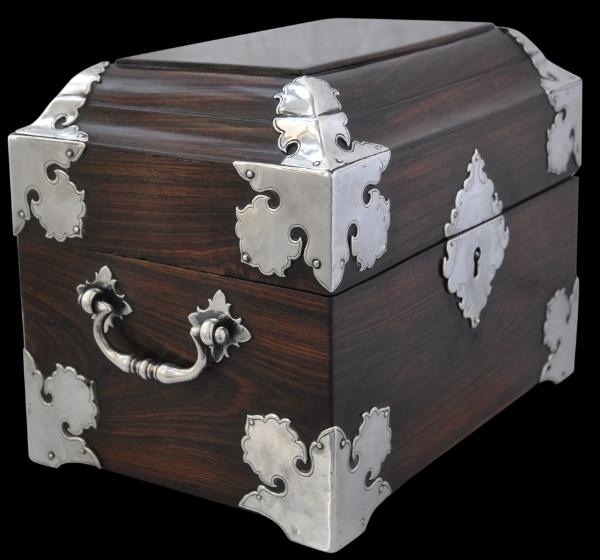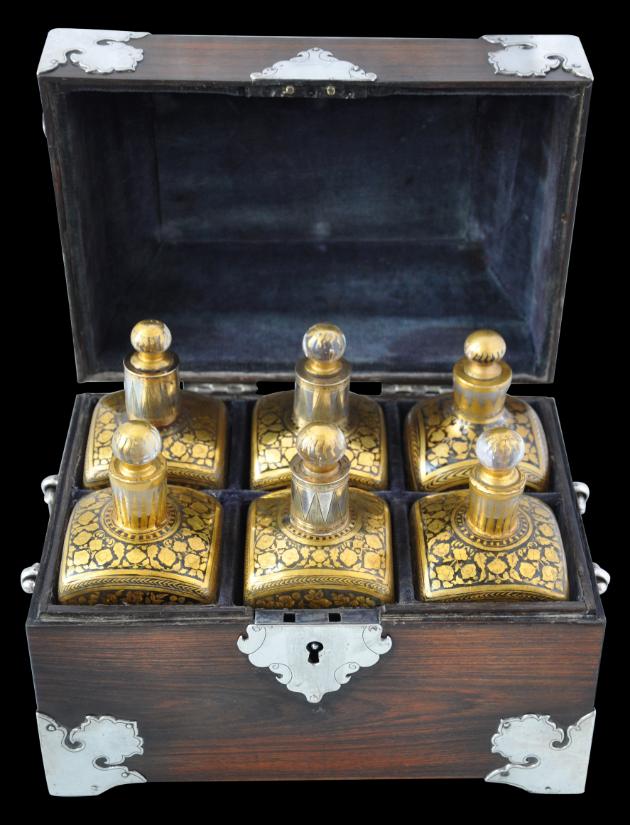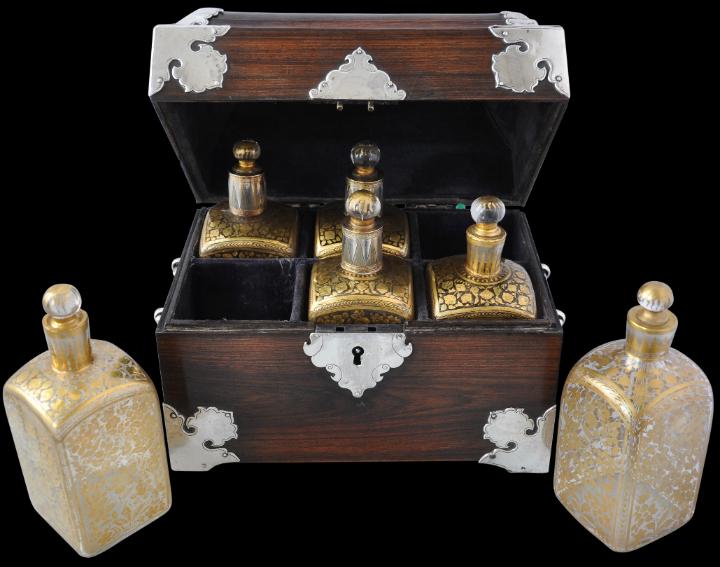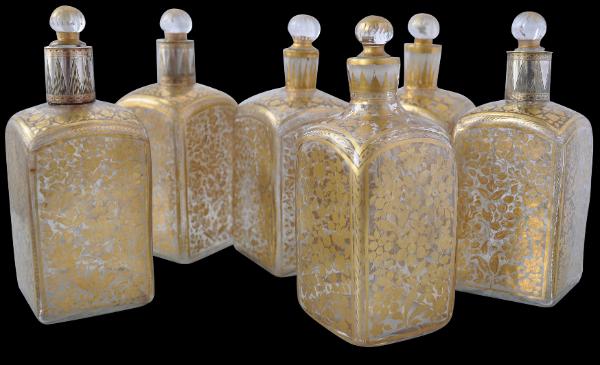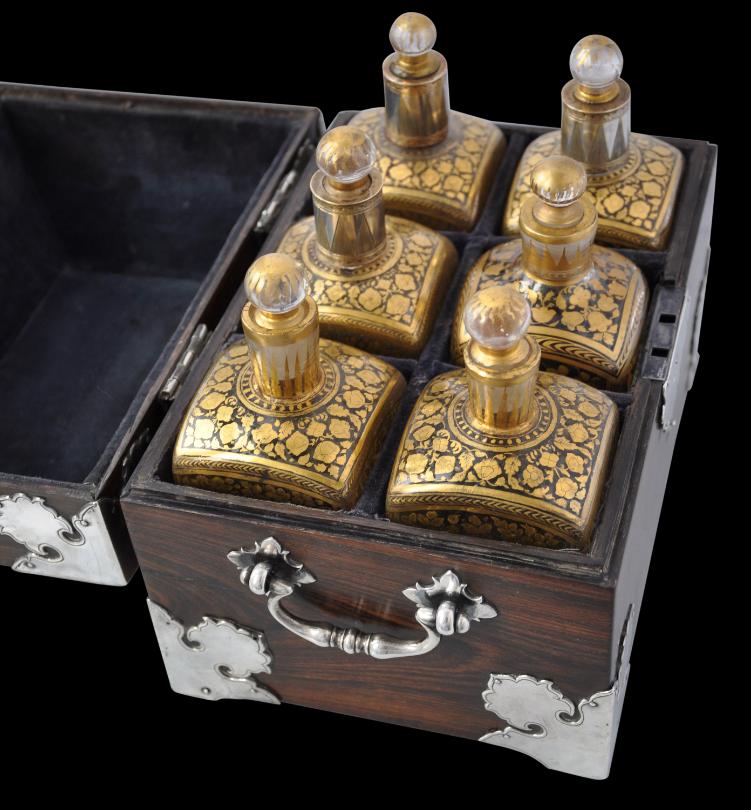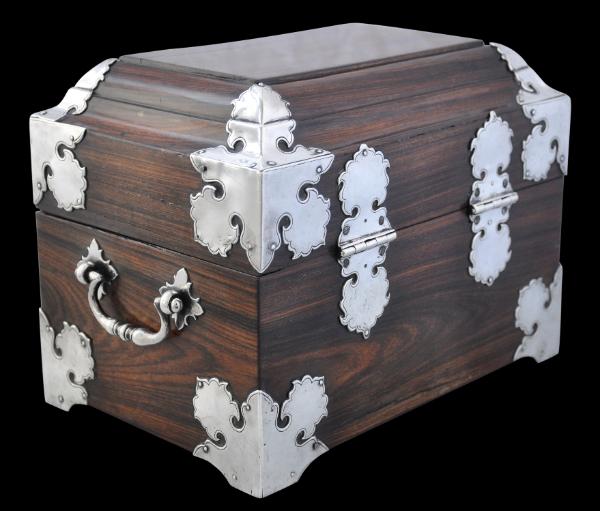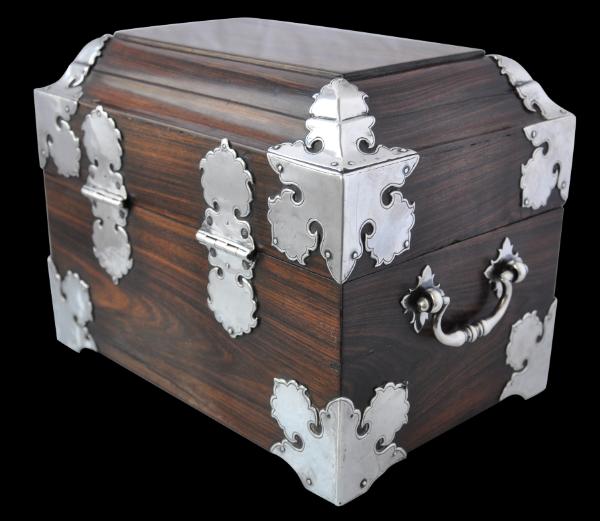Dutch Colonial Tantalus Set, Batavia
Extremely Rare Dutch Colonial Decanter Case with Silver Mounts & Six Gilded Glass Decanters
Batavia, Dutch East Indies & Gujarat, West India
late 17th-early 18th century
height of box when closed: 19cm, width: 24cm, depth: 16.2cm; typical height of bottles: 16cm
This superb decanter case with silver mounts and matching six decanters is exceptional for its rarity, quality and condition. We are aware of no other similar set from Batavia, complete or otherwise that incorporates glass bottles. Certainly none has been illustrated in the relevant literature. (A set in the Rijksmuseum attributed to the late 17th century incorporates a wooden box with silver mounts and square Japanese porcelain bottles each emblazoned with ‘VOC’ the initials of the Dutch East India Company.
The box, with its domed, hinged lid, appears to be of a variety of Javanese rosewood or similar. It has superb silver mounts on all corners, as well as a silver key plate, silver hinge plates, and cast silver handles on both sides. The mounts are impressive: they are of high-grade silver shaped as stylised Chinese cloud motifs, which is typical of eighteenth century Dutch colonial silver mounts, more typically seen on betel or sirih boxes produced for the local expatriate Dutch market. The mounts have fine, engraved silver borders.
Inside, the box is divided into six square compartments – one each for the six square gin bottles to fit snugly. The compartments and the inside of the lid are lined with dark blue velvet (the Rijksmuseum example mentioned above is similarly lined with velvet.) The box sits on four low feet that are disguised by the silver mounts.
The box is in immaculate condition. There are no losses or repairs. The lid fits tightly and evenly and the box itself sits flatly. The interior compartments are complete and rigid. The woodworking and the silversmithing are of the highest quality. Clearly, this was a costly, luxurious set when it was made or commissioned.
The decanters are Dutch in style, although shorter. They are of square form, and taper at the shoulder to a narrow, short cylindrical neck. The four sides and shoulder of each are decorated densely in gilt with matching, fine leaf and flower patterns.
Three of the bottles have engraved, parcel-gilded silver mounts around their necks. A cobalt blue glass bottle in London’s Victoria & Albert Museum, of similar form and with gilt decoration, attributed to 18th century Western India or Deccan, has a related silver mount around its neck. (See V&A, 1982, p. 394 for an illustration.)
The remaining three have gilded decoration applied straight to their glass necks. Each is fitted with a spherical stopper decorated on top with a gilt sun-burst motif.
Five of the bottles have clear pontil marks to the base. One bottle does not and may be a nineteenth century replacement. It is nonetheless well matched with the others and any difference is only apparent because of the absence of a pontil mark. Each of the bottles is in excellent condition although one has an old, small but stable crack to a section of the shoulder, visible only from certain angles.
Such bottles, which are typically seventeenth and eighteenth century, are made in two-part moulds. The two parts were then joined together to make a whole and the seams disguised by being painted over.
Carboni (2001) comments that bottles such as these were produced in Gujarat in west India. The Dutch East India Company (VOC) established a trade factory in Gujarat in 1618 and Dutch influence remained strong in Gujarat into the eighteenth century. Carboni illustrates two bottles in the Los Angeles County Museum of Art that are very similar to the examples here although with more overtly Indian motifs, and which are attributed to the second quarter of the eighteenth century. Carboni remarks that the shape of the Indian-produced bottles derived from Dutch and German moulded examples that were produced primarily in the second half of the seventeenth century and were known as case bottles on account of their being stored in cases with compartments designed to hold them.
A related set of six bottles attributed to ‘probably Gujarat, West India, 18th century’ comprised lot 230, Christie’s ‘Art of the Islamic and Indian Worlds’ October 7, 2008.
It is quite feasible that the VOC commissioned such bottles in West India, particularly, as we have seen above that the VOC also commissioned similar bottles in porcelain from Japan. Bottles of similar shape and with similar gilt decoration made from Namban lacquer were commissioned from Japan for the Portuguese market around 1600. See Impey & Jorg (2005, p. 101) for an illustration of a set of six.
European sets such as these often are described as being ‘captain’s tantalus sets’ on account of their portable nature, and so it might be with this example – perhaps it was commissioned in Batavia by a VOC captain. Alternatively, the set in the Rijksmuseum mentioned above is believed to have been commissioned as a diplomatic gift perhaps presented by the VOC to Asian rulers to help keep trade routes open. In 1686, the VOC’s High Administration in Batavia is known to have ordered a number of ‘oil-tight cellarets’ with square porcelain flasks from Japan to be used as gifts. The ‘cellarets’ were presented to rulers in Siam (1688 and 1692), Bantam (1690) and Abyssinia (1691), (van Campen & Hartkamp-Jonxis, 2011, p. 17). Perhaps this set was ordered for a similar purpose.
In any event, the set evocatively symbolises the trading routes of the day: bottles made in European form, most probably in Gujarat, and then being fitted with a box in Batavia.
This is an important, museum-worthy set.
References
van Campen, J., & E. Hartkamp-Jonxis, Asian Splendour: Company Art in the Rijksmuseum, Walburg Pers, 2011.
Carboni, S., & Whitehouse, D., Glass of the Sultans, The Metropolitan Museum of Art, New York, 2001.
Eliens, T.M., Silver from Batavia/Zilver uit Batavia, Gemeentemuseum Den Haag/W Books, 2012.
Impey, O., & C. Jorg, Japanese Export Lacquer 1580-1850, Hotei Publishing, 2005.
Krohn D.L. & P.N. Miller (eds.), Dutch New York Between East and West: The World of Margrieta van Varick, Bard Graduate Center/The New York Historical Society/Yale University Press, 2009.
Veenendaal, J., Furniture from Indonesia, Sri Lanka and India During the Dutch Period, Foundation Volkenkundig Museum Nusantara, 1985.
Victoria & Albert Museum, The Indian Heritage: Court Life & Arts under Mughal Rule, Victoria & Albert Museum/The Herbert Press, 1982.
Voskuil-Groenewegen, S.M. et al, Zilver uit de tijd van de Verenigde Oostindische Compagnie, Waanders Uitgevers, 1998.
Provenance
UK art market
Inventory no.: 1725
SOLD
